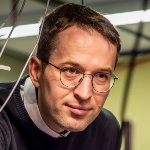Learn more about...
Welcome to the Welte Group
The goal of the CZS Junior Research Group 'Quantum Network Node' which is funded by the Carl-Zeiss-Stiftung (CZS) within the CZS Center QPhoton since August 2024 is the implementation of versatile quantum network nodes for applications in quantum communication and quantum computation. Stephan Welte acquired additional funding from the German Research Foundation (DFG) and launched a new Emmy Noether Group for quantum computing and quantum internet in January 2025 that allows him to further expand his research.
Quantum network nodes consist of optical cavities which contain arrays of individually addressed neutral atoms. The atoms in the cavity play the role of stationary qubits which can interact via photons propagating in the cavity mode.
This system will be employed to implement applications in the fields of quantum communication and computation. In particular, we will focus on cavity-mediated quantum information processing between intra-cavity atoms, the generation of optical cluster states, and optical Gottesman-Kitaev-Preskill states.
Research
Neutral atoms interacting with single photons are a fascinating experimental platform that has been explored in the last decades for a series of applications in quantum science. A highlight in the history of this research was the awarding of the Nobel Prize to Serge Haroche in 2012. Over the last years, it turned out that neutral atoms trapped at the center of an optical cavity are a promising platform for the implementation of a novel kind of communication network that is based on the laws of quantum mechanics. The practical implementation of this quantum internet is an open challenge tackled by many research groups worldwide. The general idea is to employ the strong atom-light interaction provided by the cavity to implement an efficient interface between atoms and photons. This allows processing of quantum information within the network nodes. Additionally, the photons may also propagate to other nodes in the network and can therefore be employed as flying carriers of quantum information. Landmark experiments have been performed with this experimental platform, but the performance of state-of-the-art setups was limited because - due to a stochastic atom-loading procedure - it was practically not possible to work with more than two individually controlled neutral atoms trapped in each of the network nodes.
Fortunately, there is a solution to this challenge provided by optical tweezers which were pioneered by Nobel laureate Arthur Ashkin. Optical tweezers are tightly focused laser beams in which single atoms can be trapped and positioned with high precision. Injecting many tweezers into a reservoir of cold atoms from a magneto-optical trap allows for stochastic loading of a tweezer array with a success probability of about 50% per tweezer trap. Taking a picture of the array then allows identifying the empty tweezer traps. The occupied traps are rearranged to an ordered array which is continuously refilled from a spatially separated reservoir. Combining the optical tweezer platform with an optical cavity will combine the advantages of both experimental platforms and enable working with N>2 individually controlled atoms in the cavity mode. This is the mission of the Quantum Network Node group. The envisioned system is shown in Fig. 1 and comprises a set of atoms coupled to the cavity mode. Outside of the cavity mode resides the reservoir which allows replacing intracavity atoms in case one of them is lost from its respective tweezer trap.
As a long-term vision, we plan to connect several such systems to a quantum network link on the campus in Stuttgart. A picture showing the envisioned quantum network is shown in Fig. 2.

Publications
Funding
Carl-Zeiss-Stiftung Junior Research Group for Quantum Photonics
The project is funded by the Carl-Zeiss-Stiftung within the Carl-Zeiss-Stiftung Center QPhoton (CZS Center QPhoton). The program offers four outstanding junior researchers the opportunity to establish independent research groups at the Abbe Center for Photonics in Jena, and at the Center for Integrated Quantum Science and Technology (IQST) with the University of Stuttgart, and Ulm University. The five years funding period of the Stephan Welte's CZS Junior Research Group 'Quantum Network Nodes' started in August 2024.
Emmy Noether Group
The Emmy Noether Program of the German Research Foundation (DFG) provides exceptionally qualified young researchers with the opportunity to qualify for a university professorship by independently leading a junior research group for a period of six years. Stephan Welte's Emmy Noether Group started in January 2025.
Teaching
Please see the teaching page of the institute. ↑
We are looking for motivated new team members!
Team
Project News
Contact

Stephan Welte
Dr.Leader of the CZS Junior Research Group for Quantum Photonics and Emmy Noether Group















